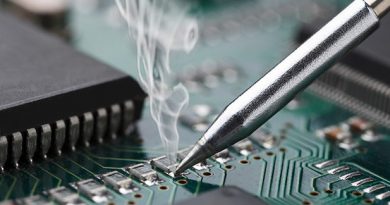How to Desolder
Let’s take a look at the basics of desoldering, with a quick step by step guide, and then we’ll go into more detail below:
- Ensure that any grease, varnish, or glue is removed from the joint before heating, otherwise the tip of your soldering iron will be fouled.
- Apply heat to the solder joint by pressing the soldering iron’s tip against the component’s lead. Take care not to overheat the component.
- If you are using a solder sucker or vacuum pump, position the device’s nozzle over the melted solder and activate it, using the suction to remove the solder. You will probably have to repeat this process multiple times to remove all the solder.
- If you are using solder wick or desoldering braid, heat the braid by leaving the wick over your soldering for a few seconds; once it’s hot you’ll feel the braid start to slide.
- Place the braid over the joint and heat it. As the solder liquefies it will begin to flow into the desoldering braid. Unlike desoldering with a vacuum pump, you shouldn’t have to repeat this process.
- After a section of braid is filled with solder, lift if off and discard.
Although soldering is a very important skill to have, desoldering is important as well and, in some cases, can be be an even more useful skill.
You need a soldering station or iron and a device for removing solder to desolder. Your soldering iron will be the heat source used to melt the solder and soldering irons between in fifteen and thirty watt range will be sufficient for most circuit board work — higher wattage irons introduce the risk of damaging components or the board itself. Do not use a soldering gun, which passes an electrical current through an internal wire that carries stray voltage which may damage your components and board.
The two types of desoldering devices are vacuum pumps (solder suckers) and desoldering braid (desoldering wick or solder wick); both are a means to the same end, so use whichever you prefer, but it’s beneficial to learn how to use both, given that one or the other may work better for a particular situation.
You won’t need to do much surface preparation when desoldering. Simply ensure that all grease, varnish, and glue are removed from the joint before heating, otherwise the tip of your soldering iron will be fouled quickly.
Because desoldering can release fumes that are detrimental to your eyes and lungs, be sure to work in a well-ventilated area. You should also wear eye protection. Be aware that molten solder can splash and burn you.
When you’re ready to desolder you’ll apply heat by pressing the soldering iron’s tip against the component’s lead and the circuit board. It should only take a few seconds to thoroughly heat the component but larger components or soldering pads can take longer.
Vacuum pumps, which look a bit like syringes, have a spring-loaded plunger and a button to release the plunger. You push it down and, when you want to suck up the solder, you position the device’s nozzle over the melted solder and press the button, thus creating a vacuum that sucks up the solder. You will probably have to repeat this process multiple times to remove all the solder.
Desoldering braid has no moving parts. First heat the braid by leaving the wick over your soldering for a few seconds; once it’s hot you’ll feel the braid start to slide. You’ll then place the braid over the joint and heat it. You should be see the solder begin to flow into the desoldering braid. Unlike desoldering with a vacuum pump, you shouldn’t have to repeat this process. After a section of braid is filled with solder it needs to be replaced: simply cut the used section from the spool.
A good way to combine both desoldering methods is to remove as much solder as you can with the vacuum pump and finish up with desoldering braid. After you’ve finished you may want to clean the desoldered area to remove any leftover resin. There are a number of commercial products available for this purpose.


Desoldering process is quite risky because it can cause damage to the components and PCB. Glad to read the blog to learn the basics of desoldering. Thanks